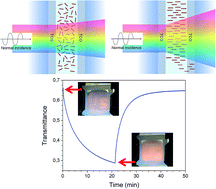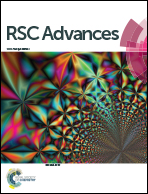Counterintuitive increase in optical scattering efficiency during negentropic orientational transition in dilute ZnO nanowire suspensions†
Abstract
We demonstrate experimentally that the electrophoretic manipulation of a ZnO nanowire (NW) suspension in polydimethylsiloxane (PDMS) causes a remarkable change in optical scattering. Counterintuitively, as an electric field is applied to the suspension and a negentropic orientational transition from a chaotically oriented state to a partially ordered (aligned) state is induced, the geometrical cross-section of the particles decreases whereas the scattering efficiency increases significantly, indicating an increase in the scattering cross-section. The alignment of the longer axis of oblong ZnO nanoparticles in the direction of incident light unexpectedly resulted in up to a 40% decrease in transmittance in the middle of the visible spectral range in the case of 150 μm thick composite films with below 0.1 vol% NW concentration. A prepared prototype smart window device exhibited spontaneous restoration of transmittance, persistent electro-optical performance (0% change in contrast after more than 10 cycles), and temporal stability against nanoparticle sedimentation and agglomeration.


 Please wait while we load your content...
Please wait while we load your content...